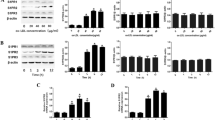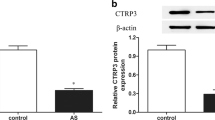Abstract
Studies have shown that apolipoprotein M (apoM), the main carrier of sphingosine-1-phosphate (S1P), is closely related to lipid metabolism and inflammation. While there are many studies on apoM and lipid metabolism, little is known about the role of apoM in inflammation. Atherosclerosis is a chronic inflammatory process. To clarify what role apoM plays in atherosclerosis, we used oxidized low-density lipoprotein (ox-LDL) to induce an inflammatory model of atherosclerosis. Our preliminary results indicate that ox-LDL upregulates the expression of S1P receptor 2 (S1PR2) in human umbilical vein endothelial cells (HUVECs). Ox-LDL-induced HUVECs were treated with apoM-bound S1P (apoM-S1P), free S1P or apoM, and apoM-S1P was found to significantly inhibit the expression of inflammatory factors and adhesion molecules. In addition, apoM-S1P inhibits ox-LDL-induced cellular inflammation via S1PR2. Moreover, apoM-S1P induces phosphorylation of phosphatidylinositol 3-kinase (PI3K)/Akt, preventing nuclear translocation of nuclear factor-κB (NF-κB). PI3K-specific inhibitors and Akt inhibitors suppress apoM-S1P/S1PR2-induced interleukin-1β (IL-1β) and tumor necrosis factor-α (TNF-α) release and affect nuclear translocation of NF-κB. In conclusion, the results demonstrate for the first time that apoM-S1P inhibits ox-LDL-induced inflammation in HUVECs via the S1PR2-mediated PI3K/Akt signaling pathway. This finding may aid in the development of new treatments for atherosclerosis.







Similar content being viewed by others
References
Borup, A., P.M. Christensen, and L.B. Nielsen. 2015. Apolipoprotein M in lipid metabolism and cardiometabolic diseases. Current Opinion in Lipidology 26: 48–55.
Dahlbäck, B. 2006. Apolipoprotein M--a novel player in high-density lipoprotein metabolism and atherosclerosis. Current Opinion in Lipidology 17: 291–295.
Nádró, B., L. Juhász, A. Szentpéteri, D. Páll, G. Paragh, and M. Harangi. 2018. The role of apolipoprotein M and sphingosine 1-phosphate axis in the prevention of atherosclerosis. Orvosi Hetilap 159: 168–175.
Feingold, K.R., J.K. Shigenaga, L.G. Chui, A. Moser, W. Khovidhunkit, and C. Grunfeld. 2007. Infection and inflammation decrease apolipoprotein M expression. Atherosclerosis 199: 19–26.
Ma, X., Y.W. Hu, Z.L. Zhao, L. Zheng, Y.R. Qiu, J.L. Huang, X.J. Wu, X.R. Mao, J. Yang, J.Y. Zhao, S.F. Li, M.N. Gu, and Q. Wang. 2013. Anti-inflammatory effects of propofol are mediated by apolipoprotein M in a hepatocyte nuclear factor-1a-dependent manner. Archives of Biochemistry and Biophysics 533: 1–10.
Christoffersen, C., M. Jauhiainen, M. Moser, B. Porse, C. Ehnholm, M. Boesl, B. Dahlbäck, and L.B. Nielsen. 2008. Effect of apolipoprotein M on high density lipoprotein metabolism and atherosclerosis in low density lipoprotein receptor knock-out mice. J Biol Chem 283: 1839–1847.
Sevvana, M., J. Ahnström, C. Egerer-Sieber, H.A. Lange, B. Dahlbäck, and Y.A. Muller. 2009. Serendipitous fatty acid binding reveals the structural determinants for ligand recognition in apolipoprotein M. J Biol 393: 920–936.
Christoffersen, C., H. binata, S.B. Kumaraswamy, S. Galvani, J. Ahnström, M. Sevvana, C. Egerer-Sieber, Y.A. Muller, and T. Hla. 2011. Endothelium-protective sphingosine-1-phosphate provided by HDL-associated apolipoprotein M. Proceedings of the National Academy of Sciences of the United States of America 108: 9613–9618.
Pirillo, A., and G.D. Norata. 2013. LOX-1, oxLDL, and atherosclerosis. Mediators of Inflammation 2013: 152786.
Vestri, A., F. Pierucci, A. Frati, L. Monaco, and E. Meacci. 2017. Sphingosine 1-phosphate receptors: Do they have a therapeutic potential in cardiac fibrosis? Frontiers in Pharmacology 8: 296.
Lai, W.Q., F.L. Chia, and B.P. Leung. 2012. Sphingosine kinase and sphingosine-1-phosphate receptors: Novel therapeutic targets of rheumatoid arthritis? Future Medicinal Chemistry 4: 727–733.
Liu, H., H. Jin, X. Yue, J. Han, P. Baum, D.R. Abendschein, and Z. Tu. 2017. PET study of sphingosine-1-phosphate receptor 1 expression in response to vascular inflammation in a rat model of carotid injury. Molecular Imaging 6: 1536012116689770.
Miraghazadeh, B., and M.C. Cook. 2018. Nuclear factor-kappaB in autoimmunity: Man and mouse. Frontiers in Immunology 9: 613.
Johnston, T.P. 2009. Poloxamer 407 increases soluble adhesion molecules, ICAM-1, VCAM-1 and E-selectin, in C57BL/6 mice. The Journal of Pharmacy and Pharmacology 61: 1681–1688.
Pyne, N.J., M. McNaughton, S. Boomkamp, N. MacRitchie, C. Evangelisti, A.M. Martelli, H.R. Jiang, S. Ubhi, and S. Pyne. 2016. Role of sphingosine 1-phosphate receptors, sphingosine kinases and sphingosine in cancer and inflammation. Advances in Biological Regulation 60: 151–159.
Ren, K., Y.J. Lu, Z.C. Mo, X. Liu, Z.L. Tang, Y. Jiang, X.S. Peng, L. Li, Q.H. Zhang, and G.H. Yi. 2017. ApoA-I/SR-BI modulates S1P/S1PR2-mediated inflammation through the PI3K/Akt signaling pathway in HUVECs. Journal of Physiology and Biochemistry 73: 287–296.
Hamed, S. 2006. Endothelial progenitor cells and atherosclerosis. Harefuah 145: 358–361.
Berliner, J.A., and J.W. Heinecke. 1996. The role of oxidized lipoproteins in atherosclerosis. Free Radical Biology & Medicine 20: 707–727.
Obinata, H. 2012. Sphingosine 1-phosphate in coagulation and inflammation. Seminars in Immunopathology 34: 73–91.
Du, J., C. Zeng, Q. Li, B. Chen, H. Liu, X. Huang, and Q. Huang. 2012. LPS and TNF-α induce expression of sphingosine-1-phosphate receptor-2 in human microvascular endothelial cells. Pathology, Research and Practice 208: 82–88.
Kosmas, C.E., I. Martinez, A. Sourlas, K.V. Bouza, F.N. Campos, V. Torres, P.D. Montan, and E. Guzman. 2018. High-density lipoprotein (HDL) functionality and its relevance to atherosclerotic cardiovascular disease. Drugs Context 7: 212525.
Hait, N.C., C.A. Oskeritzian, S.W. Paugh, S. Milstien, and S. Spiegel. 2006. Sphingosine kinases, sphingosine 1-phosphate, apoptosis and diseases. Biochimica et Biophysica Acta 1758: 2016–2026.
Książek, M., M. Chacińska, A. Chabowski, and M. Baranowski. 2015. Sources, metabolism, and regulation of circulating sphingosine-1-phosphate. Journal of Lipid Research 56: 1271–1281.
Spiegel, S., and S. Milstien. 2003. Sphingosine-1-phosphate: An enigmatic signalling lipid. Nature Reviews. Molecular Cell Biology 4: 397–407.
Luo, G., X. Zhang, and P. Nilsson-Ehle. 2004. Apolipoprotein M. Lipids in Health and Disease 3: 21.
Kurano, M., K. Tsuneyama, Y. Morimoto, T. Shimizu, M. Jona, H. Kassai, K. Nakao, A. Aiba, and Y. Yatomi. 2018. Apolipoprotein M protects lipopolysaccharide-treated mice from death and organ injury. Thrombosis and Haemostasis 118: 1021–1035.
Jiang, Y., L.L. Jiang, X.M. Maimaitirexiati, Y. Zhang, and L. Wu. 2015. Irbesartan attenuates TNF-α-induced ICAM-1, VCAM-1, and E-selectin expression through suppression of NF-κB pathway in HUVECs. European Review for Medical and Pharmacological Sciences 19: 3295–3302.
Osborn, L., C. Hession, R. Tizard, C. Vassallo, S. Luhowskyj, G. Chi-Rosso, and R. Lobb. 1989. Direct expression cloning of vascular cell adhesion molecule 1, a cytokine-induced endothelial protein that binds to lymphocytes. Cell 59: 1203–1211.
Takuwa, Y., Y. Okamoto, and K. Yoshioka. 2012. Sphingosine-1-phosphate signaling in physiology and diseases. Biofactors 38: 329–337.
Brown, J.D., C.Y. Lin, Q. Duan, G. Griffin, A. Federation, R.M. Paranal, S. Bair, G. Newton, A. Lichtman, A. Kung, T. Yang, and H. Wang. 2014. NF-kappaB directs dynamic super enhancer formation in inflammation and atherogenesis. Molecular Cell 56: 219–231.
Funding
The authors sincerely acknowledge the financial assistance provided by the National Natural Science Foundation of China (No. 81770490) and the Construct Program of the Key Discipline in Hunan Province (Basic Medicine Sciences in University of South China).
Author information
Authors and Affiliations
Corresponding author
Ethics declarations
Conflict of Interest
The authors declare that they have no conflict of interest.
Electronic Supplementary Material
Supplementary Fig. 1
Effect of apoM-albumin on inflammatory factors and adhesion factors induced by ox-LDL in endothelial cells. a Western blotting was used to detect the expression of IL-1β and TNF-α. (PNG 148 kb)
Supplementary Fig. 2
Effect of different concentrations of apoM-S1P on ox-LDL-induced inflammation of HUVECs. a Western blotting was used to detect the release of ICAM-1 and VCAM-1 in ox-LDL-induced HUVECs by apoM-S1P at different concentrations. * P < 0.05 vs. control group, n = 3. (PNG 131 kb)
Rights and permissions
About this article
Cite this article
Zheng, Z., Zeng, Y., Zhu, X. et al. ApoM-S1P Modulates Ox-LDL-Induced Inflammation Through the PI3K/Akt Signaling Pathway in HUVECs. Inflammation 42, 606–617 (2019). https://doi.org/10.1007/s10753-018-0918-0
Published:
Issue Date:
DOI: https://doi.org/10.1007/s10753-018-0918-0




